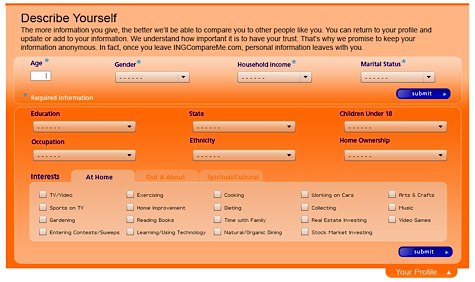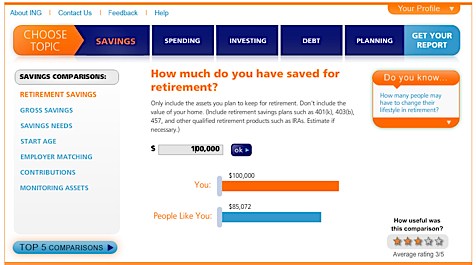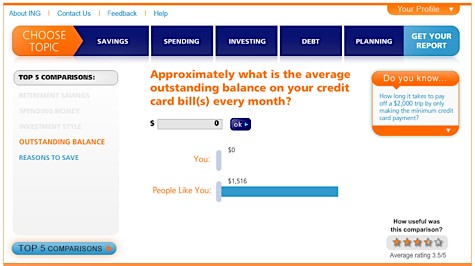INGCompareMe is a new web tool from ING that helps you compare your bank balance, savings and investment levels against those of your peers.
The first rule in finance? Know yourself!
Are you curious about how well you stack up against others when it comes to your personal finances? Do you wonder what your net worth should be by now? We receive a lot of this kind of information and transparency through tools like Mint, Wesabe and NetWorthIQ, which also have a community feel built around them.
I like free tools like these — there’s always something new you may be able to learn about yourself when you use them. So when I heard that ING just launched a new peer comparison tool called INGCompareMe a few days ago, I decided to check it out.

INGCompareMe, A Free Savings Comparison Tool From ING
Here are the tool’s objectives:
It lets you see how you measure up against your peers, those people with the same profile as you have. ING asks you a bunch of questions, and based on your response, you’re scored for how you handle your money. You can then analyze yourself in various financial areas such as saving, spending, investing and debt management and gain visibility on how well you’re doing.
Once you see where you stand, you may decide to take action, as peer comparisons can be pretty motivational. By knowing how others are doing on average, you may feel inspired to do a better job with your money. Maybe subtle peer pressure works in this case?
Compare Your Bank Balance With Those Of Your Peers
ING initially surveyed 5,000 people who were saving for retirement and the data they gathered here is what’s being used for comparison purposes through the tool. Here’s what else the survey found: those people who spent time dwelling on their finances more often saved 60% more than those who didn’t. I guess that makes sense! If money and your finances are a priority for you and happen to be in your mind often (in a positive way), I can see why you’d be doing well in this area of your life.
The data you enter then gets incorporated in the information used by the tool; there are measures in place to ensure that the comparative data remains fresh and current, and accurately reflects present conditions.
So how do you use it? It’s pretty simple really. As I’ve mentioned, INGCompareMe has a simple questionnaire you fill up about yourself and your habits / interests (for profiling purposes), after which you answer a set of questions about your finances. Throughout the process, your identity is kept completely anonymous. You won’t have to worry about anything since they don’t ask for sensitive information at all.
Here are some snapshots of this application:

Your retirement savings are compared against those of your peers.

How much credit card debt do you carry?
After I looked it over and entered some information, it allowed me to print out a report that detailed my results. Here is the PDF report that it generated for me (this is just a sample).
I appreciate how ING took the time to prepare a cool tool like this to help us evaluate our financial picture. I’d use a profile analysis like this to gauge my financial health. Do you think this helps? How does your money stack up?
Copyright © 2009 The Digerati Life. All Rights Reserved.

{ 10 comments… read them below or add one }
I plan on doing this once I have some spare time, what scares me is I expect to find I’m doing a heck of a lot better than my peers. That is not good because I’m only doing what should be normal, nothing special. Thanks for the summary, you saved me the trouble of learning it myself.
I ran this the other day when I received the announcement email from ING Direct. It was kind of interesting. I liked the in-depth comparisons.
This is appears to be a useful tool. Will run it :).
I just checked this out and found it rather lame. It does have some interesting information, but it’s primarily a marketing tool for ING financial specialists. Why do I need to contact a financial adviser because my rent is lower than average? Say what?
It also had some weird questions and was missing others I would have liked to see. For instance – how much ‘spending money’ do you have after the necessities – food, clothing, shelter? It sounds like a simple question, but it’s kind of not. Do you include eating out in food, or spending? How about that jacket that you didn’t really need? What about utilities? I actually entered $200 (my ‘spending money’ each month) before I read the question a second time.
I would have loved to see a question about your average living expenses, or the amount you save each month. While they asked how much you currently had saved, they didn’t ask how much you were continuing to save. I would have found those much more interesting.
I can see how the call to “contact a financial adviser” can be a bit annoying but honestly, stuff like that doesn’t bug me that much. I did give them the benefit of the doubt and just ignored that part. 🙂 I understand the whole bit about it being a marketing tool, and I tried it out knowing what it was, but I felt it had some value if taken for what it is, a piece of free software that tries to provide you visibility into your saving/spending habits.
Also, for being a free tool, I think it’s not bad. It can certainly be improved and maybe they’ll do so in time. I like how they came up with that pdf file in the end — at least they give you that output in the end like a scorecard (or report card) that gives you some basic idea of your financial status.
@Slinky, I agree that they could do better with some of these questions. Maybe they’ll be able to read what we have to say about it!
Sounds neat, I’ll have to check it out later. I am always curious how I stack up against the crowd, though it doesn’t drive my decisions.
It’s a good engagement tool. But I think the key thing about engagement tools is the way in which they help the consumer turn insights into actions. I’m not clear from the post if that is assisted or left entirely to the consumer. I’ll check it myself. thanks for the post.
@Bill,
They do engage in the sense that they ask you to contact them if you need any assistance/help with your finances. They also suggest that you bring this information to your financial planner to see if it can be discussed or used to help your particular situation.
I think it’s a good way to start a conversation, certainly, whether it be with your planner, your hired professional or yourself. Great comments!
Not that I use it but I would think a tool like Mint, using real data, would be more informative that this.
I also enjoyed the comparison tool… seems like a useful bit of info, thank you!